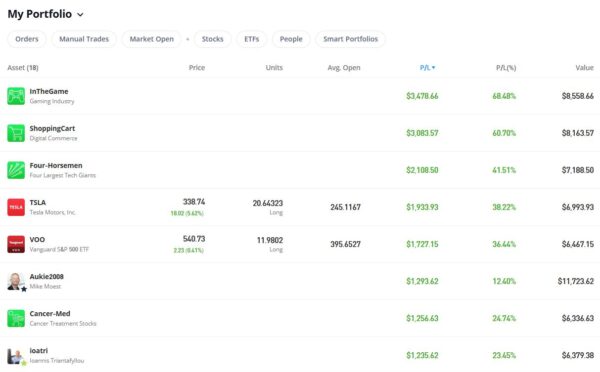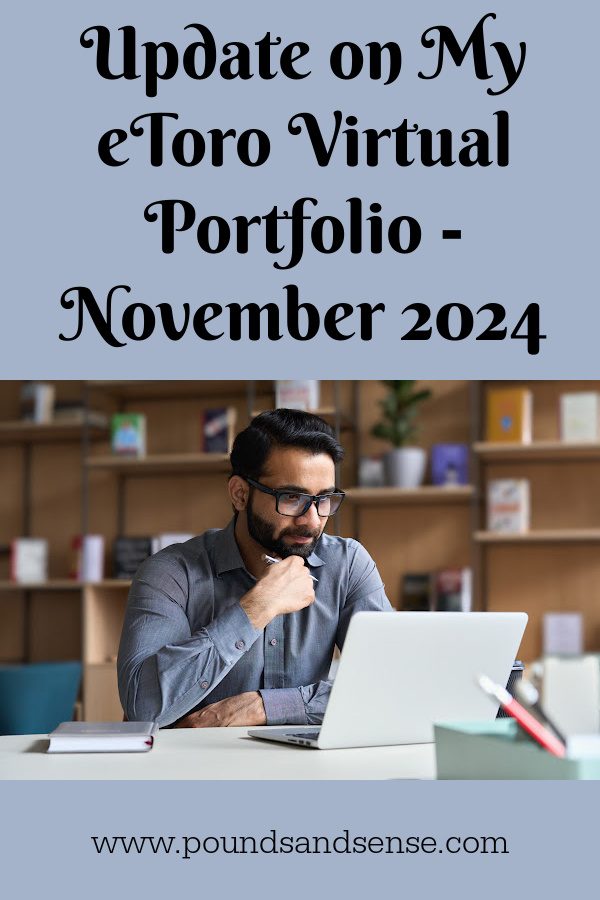Update on My eToro Virtual Portfolio – November 2024
A little over a year ago I published this update about my eToro virtual portfolio and some lessons I had learned from it. I originally reviewed eToro in this blog post.
I thought PAS readers might be interested to see an update about how my eToro virtual portfolio is doing today and any further lessons to be learned. As you may know, I already publish monthly updates on my real investments and how they are doing, the latest of which you can read here.
Let’s start with the basics, though…
What is eToro?
eToro is a Israeli fintech company based in Cyprus. The company also has registered offices in the UK, US and Australia. It is a hugely popular platform with 25 million customers from over 140 countries across the world.
eToro is regulated and authorised in the UK by the Financial Conduct Authority (FCA) and is covered by the Financial Services Compensation Scheme (FSCS). That means if eToro were to go bust any deposits with them up to £85,000 would be protected. Of course, the FSCS doesn’t protect you if you lose money simply due to your investments performing poorly.
eToro offers a wide range of investment products, from individual shares to cryptocurrencies, commodities to ETFs, currency pairs to copy trading, and thematic investing via smart portfolios. Today, though, I’m focusing on a feature that doesn’t require any outlay at all. This is the facility to operate a $100,000 virtual portfolio on the platform, to familiarize yourself with how it works and test out trading and investing strategies.
I have been an eToro investor for nearly three years now. I started with a virtual portfolio, but I have also invested some real money. I do still use my virtual portfolio, however, and continue to learn valuable lessons from it. So today I thought I’d set out some of these.
I’ll start by showing you some data on how my virtual portfolio has been performing as of November 2024. As I have quite a lot of different investments in my VP, I have taken two separate screen captures showing first the best performing and then the worst performing. As a matter of interest, I am now up by over $17,000 overall. Obviously I can only wish that was real money!
Table of Contents
Best Performing Investments

Worst Performing Investments

Some Lessons Learned
I hope you found the screen captures of my virtual portfolio interesting. They include most of my current investments apart from one or two in the middle. I can’t discuss every investment in detail here, but as promised here are some of the lessons I have drawn from my experiences to date.
Time in the market really does matter
As my financial adviser, Mike, often reminds me, one of the main keys to successful investment is time in the market. As long as you have a good-quality, well diversified portfolio, over time the inevitable peaks and troughs will even out, and the likelihood of making a good long-term return will increase (though, of course, with all investing there is never any guarantee).
Two years on from when I opened my eToro virtual portfolio, here’s a snapshot of how it’s doing overall…
![]()
As you can see, currently my inexpertly-picked portfolio is showing over $17,000 of profit. In my last VP update in July 2023, it was showing a loss of over $3,000. Since then I haven’t made any major changes to the portfolio, but over the last year there has been an impressive turnaround. Apart from my unsuccessful (okay, disastrous) experiments investing in commodities, the profit would be significantly bigger than this. And, as you may have noticed, there has been one other thing holding overall performance back…
Renewable energy companies have performed surprisingly poorly
You might assume that with climate change and the manic quest (in the UK at any rate) to achieve Net Zero, investing in renewables should be a profitable strategy.
I used to think so too, so in my eToro VP I invested in two smart portfolios in this sector. One is called Renewable Energy and the other Golden Energy. As you can see from my second screen capture, both have performed poorly and are at the bottom of the table. Golden Energy (which invests in gold and energy companies) is down by almost 17%, while Renewable Energy is right at the bottom, having gone down in value by nearly 45%. Obviously I am glad I don’t have any real money in these smart portfolios.
In a somewhat ironic twist, my investment in a smart portfolio called Oil Worldwide is actually showing a profit of around 16%. Regular readers will be aware that I also have some real money in Oil Worldwide.
I don’t really know why companies in the renewable energy sector should be under-performing so badly. But it does make the point that what may appear to be ‘nailed-on’ profitable investments can still end up losing money. As I said earlier, there are never any guarantees!
You can read my blog post here about smart portfolios, which allow you to invest thematically on eToro.
IT companies generally have done well in the last two years
As you can see from my first screen capture, my top three virtual investments have all been in the information technology field. At the top is the In the Game smart portfolio, which is focused on the gaming industry. This has delivered a staggering 68% profit. Not far behind is the Shopping Cart smart portfolio, devoted to online shopping technology, which has delivered a 61% return.
And in third place comes the Four Horsemen portfolio, which incorporates shares in the four leading global IT companies, Microsoft, Apple, Amazon and Google. This has generated a 42% profit, partly due to their involvement in the fast-growing AI field.
Obviously there is no guarantee that this trend will continue. But if you are looking for sectors in which to invest, information technology has certainly been delivering impressive returns recently.
Health is another sector worth watching
As you can see, one of the best performing investments in my virtual portfolio was Cancer-Med (25% profit). I had personal reasons for wanting to invest in this, as my partner Jayne died from cancer and I have been treated for prostate cancer myself. Obviously a lot of research money goes into cancer, and successful treatments can prove extremely lucrative for the companies concerned.
I also invested some of my virtual funds in Diabetes-Med. This is a smart portfolio covering companies in the field of diabetes care, treatment and prevention. Again, as someone who has previously been diagnosed prediabetic, I had a particular interest in this. And with diabetes on the rise across the world, it did seem to me it was a sector with good profit potential. It has also delivered a profit for me, albeit a relatively modest 7%.
Copy trading can be profitable
Also among my best-performing investments have been two copy trading portfolios. As you can see, the most profitable has been Aukie2008 (Mike Moest). Following him has has generated a profit of around 16% over two years for me. Regular readers will know that I also invested some real money following this trader and have done pretty well from this also.
Also in my VP I am following two other copy traders, Nezatron and ioatri. Nezatron is showing a modest net profit (for me) of around 8%, while ioatri has made a rather more impressive 23% return, putting him in the top part of my performance table.
I am a fan of the copy trading feature on eToro, though naturally some traders do better than others. Please read my blog post about copy trading on eToro for more information about this feature.
Final Thoughts
So those are five more lessons I have learned from my eToro virtual portfolio. I don’t claim any of them are particularly earth-shattering or that they represent deep universal truths. But I have found all of them valuable in different ways and they will certainly inform my investing in future. Obviously bear in mind that the results quoted above are based on my experiences over the last two years since I opened my virtual portfolio. Over other time periods, the numbers would no doubt be different.
If you are interested in investing and/or trading, I do therefore recommend setting up an eToro virtual portfolio and trying different strategies with it. I shall continue to do so myself, alongside my real investments in eToro and elsewhere.
To remind you, you can read my article about setting up an eToro account – which automatically includes a $100,000 virtual portfolio – here. You can also read how my actual (real money) investments with eToro are performing in my monthly investment updates, of which this is the latest.
As always, if you have any comments or questions about this article – or eToro more generally – please do post them below.
Disclaimer: I am not a professional financial adviser and nothing in this post should be construed as personal financial advice. You should always do your own ‘due diligence’ before investing, and seek professional advice if in any doubt how best to proceed. All investing carries a risk of loss.
Please note also that posts on Pounds and Sense may include affiliate links. If you click through these and make a purchase or investment, I may receive a commission for introducing you. This will not affect in any way the price you pay or the product/service you receive. In some instances bonuses and other promotional incentives may only be available if you click through my link.

